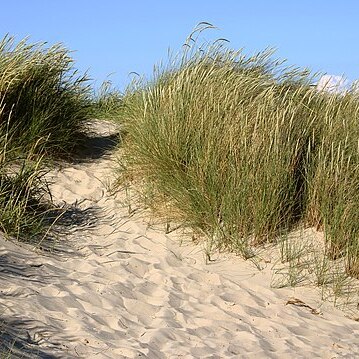Robust, tufted, rhizomatous perennial, 0.6-1.3 m high; culms creeping through blown sand. Leaf blade up to 750 mm long, rolled, appearing setaceous; ligule a conspicuous tapering unfringed membrane which splits into 2. Inflorescence a very narrow, spikelike panicle; old inflorescences persistent until autumn. Spikelet 9-13 mm long, laterally compressed, disarticulating above glumes; glumes equal to or longer than spikelet, keeled; lower glume 1-nerved; upper glume 1-3-nerved. Floret 1; lemma less firm than glumes, 5-7-nerved, keeled, lobed, mucronate at apex; callus hard, knob-like; anther 4.5-6.5 mm long. Flowering time Oct.-Dec.
A grass. It is a perennial plant 1.2 m high. It grows in clumps. It has extensive creeping and branching rhizomes. The leaves are tightly rolled inwards. They form straw like tubes. They are 60 cm long. The open leaf has hairy veins along it on the upper surface. Where the leaf sheath and blade join there is a membrane 3 cm long clasping the stem. It is yellowish-green. The flowers are in spike like clusters. They are cylindrical. These are 27 cm long and on a rigid stem. The spikelets contain male and female flower parts.
Robust, tufted perennial 600-1300 mm high; rhizomatous; culms creeping through blown sand. Leaf blade to 750 mm long, rolled, appearing setaceous; ligule a conspicuous, tapering, unfringed membrane that splits into two. Inflorescence very narrow, spike-like; old inflorescences persistent until autumn. Spikelet 9-13 mm long; callus hard, knob-like; anther 4.5-6.5 mm long.
Robust, rhizomatous perennial to 1 m. Leaves rolled, rigid. Spikelets in a narrow, spike-like panicle, straw-coloured.

